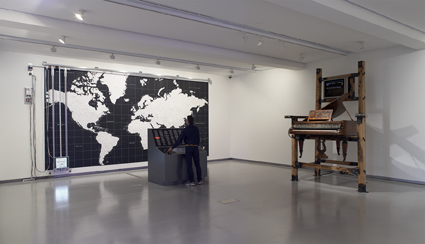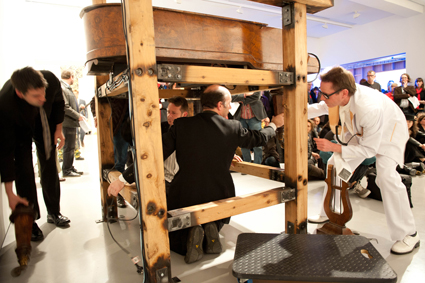returning the gift: conceptualising music
philip brophy: slave pianos, the gift—redaction & decontamination

Slave Pianos, installation
photo Christian Capurro
Slave Pianos, installation
SLAVE PIANOS’ PERFORMANCE OF THE GIFT—REDACTION AND DECONTAMINATION (2011) AT THE MONASH UNIVERSITY MUSEUM OF ART CLOSED A PARTIAL SURVEY OF SOME OF DANIUS KESMINAS’ VARIED COLLABORATIVE PROJECTS. THE GIFT SPECIFICALLY ‘PERFORMANCISED’ THREE ROOMS CONTAINING KESMINAS’ PROJECTS—MEANING SLAVE PIANOS ELABORATED THE THEMES AND REFERENCES FROM EACH OF THESE INSTALLED SPACES INTO PERFORMED WORKS.
Let me briefly sketch these complex spaces. The Slave Pianos room contained a Cold War-era fabrication of a global bunker for disseminating obtuse musical texts composed by contemporary artists. These were ‘audio-visualised’ via a huge wall map across which an automated map-plotter bore a small TV screen which named a piece’s title, date and composer when it reached that composer’s country of residence, at which point a MIDI-controlled grand piano (affixed to a fashioned electrical chair) ‘performed’ the quoted piece. The Punkasila room contained numerous artefacts from Kesminas’ collaboration with the Indonesian agit-punk group Punkasila, displaying the band’s ‘meta-batik’ costumes, hand-painted banners and rifle-prop guitar constructions. And the Pipeline To Oblivion room projected Kesminas’ documentary interview with a Lithuanian farmer who illegally distilled vodka, while in the centre of the room a working still was hooked up to a pump organ to play a Lithuanian folk melody.
While the installations featured the objects and texts described above, the Slave Pianos’ staging of those objects and texts rendered all references musical. The rooms generated the score for the performance, and in turn illuminated their musical genesis. All of Kesminas’ art is wilfully and sardonically tainted by music and musicology, and while many of his performance projects have occurred in a variety of music venues and contexts, his Slave Pianos project often occurs within galleries and museums. The Gift was an astounding declaration of the trajectory Slave Pianos has refined over decades.
Now if this were 1961, we could continue tra-la-la-ing down a Fluxus garden path. I could programmatically champion how the gallery allows space for contra-musical pro-conceptual investigations of music—a sort of music heavy on conceptualising the performative and light on exploring the sonic. For those early Fluxus manoeuvres were warranted retorts to the academicism of notational avant-garde music—especially the revolutionary atonal/post-tonal modes which had struggled to define a post-war canon for the concert hall. Inspired by John Cage’s late 50s philosophising on musical eventfulness and procedures for activating a consciousness in musical practice, Fluxus were trans-medial in the true Dada tradition, de-specifying art forms and in the process welcoming actionist tactics and conceptual strategies.
Unfortunately, if one reads supposedly critical (let alone theoretical) writing on contemporary music sixty years later in 2011, it seems we are still living in 1961. Many things currently appear to be at stake—the drive to explore, the will to comment, the need to subvert, the power to startle, the mandate to re-orient—but a theatre of ideological gestures qualifies these views. Rarely has experimental/exploratory music/sound/art (pick your own T-shirt: one size fits all) evidenced conceptual rigour which opens up a critical space for discussing music. In place, experimental music enacts experimentalism as a series of codified tropes, almost as if the 60s is fetishised as some golden period where, well, experiments were undertaken. Sure, modulating nodes like punk, Max-DSP, globalism, the internet etc have changed a few things in the now, but as a survey of the names of the myriad new-sound/music festivals around the world attest, their claims to radicalism reside in their branded logos more than generative outcomes.
Yet Slave Pianos’ staging of The Gift achieved so much of what Fluxus only ever flaunted in its insular pseudo-utopian conceptualisation of a revolutionary/liberating/empowering art. Far from making effete claims to being music of an exploratory post-Cageian form, The Gift instead uses music as a platform to articulate and vent a dense conceptualism of music as a textual force. Hilariously quoting risible bourgeois waffle about ‘the art world’ from a Joanna Murray-Smith play, an autobiography by Nikola Tesla, ruminations on Nietzsche’s pessimistic attraction to pianos and Soviet journalist Vitali Vitaliev’s earthy embrace of vodka, The Gift plotted an obtuse series of incidents where music and creativity are treated as produce of ‘the gifted.’ Kesminas seems bent on debunking creativity as a privileged act, and his conceptual interrogation of the muse in music—via his quoted texts performed by actor Richard Piper—ably queries musical production and its musicological reception.

Slave Pianos, The Gift: Redaction and Decontamination, Performance
photo Andrius Lipsys
Slave Pianos, The Gift: Redaction and Decontamination, Performance
There is boldness in this move. In the arts, few things are so upsetting to more people than shifting (more like dragging screaming) music into the conceptual domain. That most turgidly theoretical and nullifying abstract of places wherein the sonic, the experiential, the exploratory should not venture. The fundamentalist tenets of music believe it to be somehow capable of mystically escaping discourse. I sense this in just about any writing on sound and music: the feeling that the words distrust themselves, that they are dreadful linguistic apologies for the supreme essentialism of ‘music itself.’ Such a view verges on the theological: as if to speak about sound/music with any conceptual bent incurs wrath. This implies that music is mired by an awful iconic orthodoxy which prohibits discourse due to sound and music’s inalienable unutterability.
Cage—in a supreme stroke of authorial scripture which is rarely critically attributed to his oeuvre—actively halts discussion post-performance. It is as if the event—the thing which most excited Fluxus—allows conceptual birthing but forbids conceptual growth. Discussion about the Cageian legacy tends toward discussing the concepts behind the sounds of works like the Variations series (its instructions, their interpretation, the works’ eventfulness etc), rather than discussing the sounds conceptually. This has partially shaped the ongoing impasse of incisive writing on new/experimental sound/music: its critical writing enforces either humanist performance mechanics (paraphrasing traditional jazz ideologies) or reverts to authorial acquiesence. It’s a situation I find entirely conservative.
The thing is, Cage—via Duchamp—gave me license to accept that all material and plastic arts (ie everything but literature) are powerful enough to carry any conceptual weight thrust on them. Music especially seems that way to me. Far from shirking from the fear that one might ‘kill’ sound/music by being too analytical about its materiality—let alone its cultural semiotics—I’ve always figured sound/music to be an immersive world which activates critically reflexive thought while it incites psychologically responsive feeling. To write about music—to acknowledge its textual potentiality—is inevitable, exciting and productive. To continue invoking historically proscribed pseudo-radical truisms about music’s linkage to avant-garde, experimental and exploratory strategies seems quite the opposite.
Experiencing The Gift as an actual outcome of Fluxus practice, I was forcefully reminded that ye olde white cube still has power. This particular Slave Pianos event maximised the ‘void-space’ of art to consider music in a way that is unthinkable in the current social contexts for experimental/exploratory music-making. And while maybe a recording of The Gift would be played as few times in my collection as my Cage recordings, the eventfulness of the staging sharpened the conceptual precision of the project. More Godardian than Cageian, The Gift returned the conceptual to music. Think of it as a welcome home gift.
Slave Pianos, Punkasila, Pipeline to Oblivion, 3 Projects by Danius Kesminas and collaborators, curator Max Delany; Slave Pianos performance, The Gift—Redaction and Decontamination, July 23; Monash University Museum of Art, Caulfield campus, Melbourne, May 5-July 23
RealTime issue #105 Oct-Nov 2011 pg. 37






